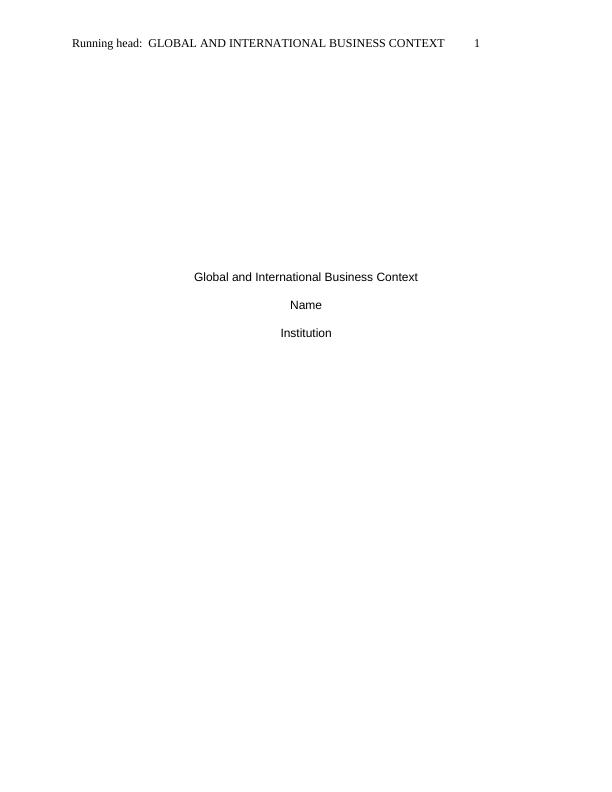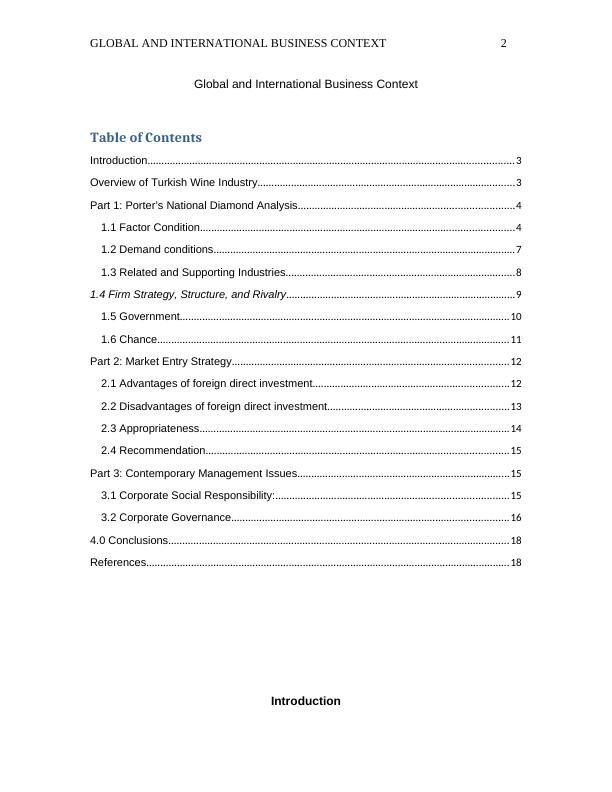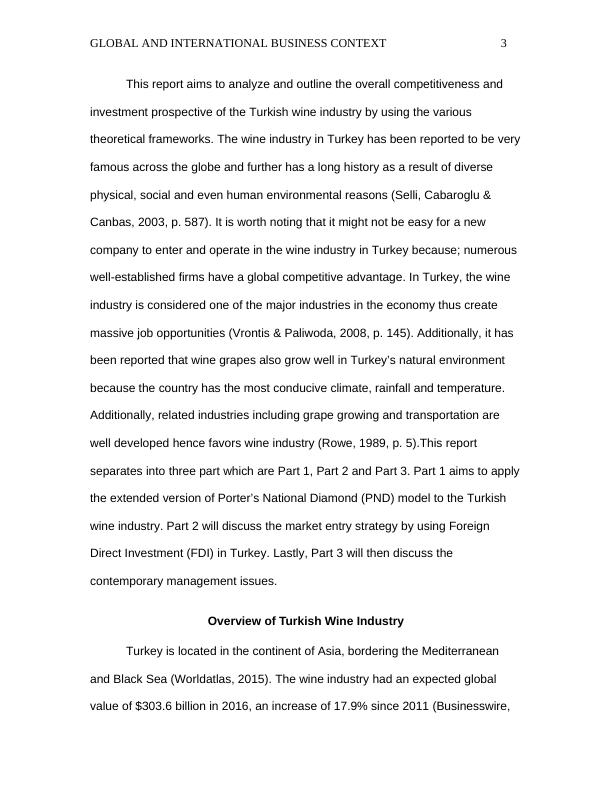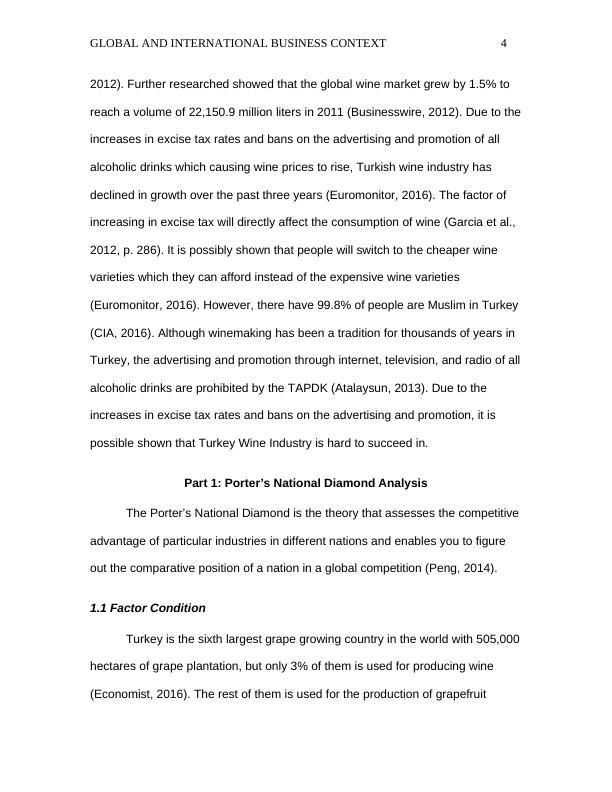Ask a question from expert
Global and International Business Context Assignment
21 Pages5414 Words72 Views
Added on 2020-11-13
Global and International Business Context Assignment
Added on 2020-11-13
BookmarkShareRelated Documents
Running head: GLOBAL AND INTERNATIONAL BUSINESS CONTEXT1Global and International Business ContextName Institution

GLOBAL AND INTERNATIONAL BUSINESS CONTEXT 2Global and International Business ContextTable of ContentsIntroduction...................................................................................................................................3Overview of Turkish Wine Industry............................................................................................3Part 1: Porter’s National Diamond Analysis.............................................................................41.1 Factor Condition................................................................................................................41.2 Demand conditions............................................................................................................71.3 Related and Supporting Industries..................................................................................81.4 Firm Strategy, Structure, and Rivalry..................................................................................91.5 Government......................................................................................................................101.6 Chance..............................................................................................................................11Part 2: Market Entry Strategy...................................................................................................122.1 Advantages of foreign direct investment......................................................................122.2 Disadvantages of foreign direct investment.................................................................132.3 Appropriateness...............................................................................................................142.4 Recommendation............................................................................................................15Part 3: Contemporary Management Issues............................................................................153.1 Corporate Social Responsibility:...................................................................................153.2 Corporate Governance...................................................................................................164.0 Conclusions..........................................................................................................................18References..................................................................................................................................18Introduction

GLOBAL AND INTERNATIONAL BUSINESS CONTEXT 3This report aims to analyze and outline the overall competitiveness and investment prospective of the Turkish wine industry by using the various theoretical frameworks. The wine industry in Turkey has been reported to be veryfamous across the globe and further has a long history as a result of diverse physical, social and even human environmental reasons (Selli, Cabaroglu & Canbas, 2003, p. 587). It is worth noting that it might not be easy for a new company to enter and operate in the wine industry in Turkey because; numerous well-established firms have a global competitive advantage. In Turkey, the wine industry is considered one of the major industries in the economy thus create massive job opportunities (Vrontis & Paliwoda, 2008, p. 145). Additionally, it has been reported that wine grapes also grow well in Turkey’s natural environment because the country has the most conducive climate, rainfall and temperature. Additionally, related industries including grape growing and transportation are well developed hence favors wine industry (Rowe, 1989, p. 5).This report separates into three part which are Part 1, Part 2 and Part 3. Part 1 aims to applythe extended version of Porter’s National Diamond (PND) model to the Turkish wine industry. Part 2 will discuss the market entry strategy by using Foreign Direct Investment (FDI) in Turkey. Lastly, Part 3 will then discuss the contemporary management issues. Overview of Turkish Wine IndustryTurkey is located in the continent of Asia, bordering the Mediterranean and Black Sea (Worldatlas, 2015). The wine industry had an expected global value of $303.6 billion in 2016, an increase of 17.9% since 2011 (Businesswire,

GLOBAL AND INTERNATIONAL BUSINESS CONTEXT 42012). Further researched showed that the global wine market grew by 1.5% to reach a volume of 22,150.9 million liters in 2011 (Businesswire, 2012). Due to theincreases in excise tax rates and bans on the advertising and promotion of all alcoholic drinks which causing wine prices to rise, Turkish wine industry has declined in growth over the past three years (Euromonitor, 2016). The factor of increasing in excise tax will directly affect the consumption of wine (Garcia et al., 2012, p. 286). It is possibly shown that people will switch to the cheaper wine varieties which they can afford instead of the expensive wine varieties (Euromonitor, 2016). However, there have 99.8% of people are Muslim in Turkey(CIA, 2016). Although winemaking has been a tradition for thousands of years in Turkey, the advertising and promotion through internet, television, and radio of allalcoholic drinks are prohibited by the TAPDK (Atalaysun, 2013). Due to the increases in excise tax rates and bans on the advertising and promotion, it is possible shown that Turkey Wine Industry is hard to succeed in. Part 1: Porter’s National Diamond AnalysisThe Porter’s National Diamond is the theory that assesses the competitiveadvantage of particular industries in different nations and enables you to figure out the comparative position of a nation in a global competition (Peng, 2014). 1.1 Factor ConditionTurkey is the sixth largest grape growing country in the world with 505,000hectares of grape plantation, but only 3% of them is used for producing wine (Economist, 2016). The rest of them is used for the production of grapefruit

GLOBAL AND INTERNATIONAL BUSINESS CONTEXT 5pectin and dried fruit pulp (Gumus, 2016). Grapes are the main natural resourcesof producing wine. Based on the research, it shows that the raw material of producing wine will not be hard to find. Turkey has 1200-1500 named grape varieties of that 600-800 are genetically different (Wineofturkey, 2016). Besides, Turkey has 34 varieties of wine grape, with 22 native varieties. Based on the advantages, it is possibly shown that Turkey has the potential of producing many different types of wine products.Based on the Trading Economics (2015), Turkey had a population of 28.2 million in 1960. The population of Turkey has been continuously growing up since 2007 which is from 70.59 million and stood at 78.74 million in 2016 (shown in Diagram 1). According to the research, it is possibly shown that Turkey will not face the shortage of workers, despite this is not entirely accurate. However, the employment rate in the agricultural industry is decreased by 27.7% which is 1988compared to 2014 (The World Bank, 2014). This research shows that people hard to find the labor in Turkey and the grapes price could be expensive. Diagram 1

GLOBAL AND INTERNATIONAL BUSINESS CONTEXT 6According to McDermott (2005, p. 23), factor condition comprises of factors that the company uses in Turkey that is related to the resources to the firm and might consist of the amount of natural resources, the innovative product developers, and even the skilled labor that the company has in producing high-quality brands. These can comprise of factors associated with high advantage and are found in Turkey and are subsequently build upon buying the firm to a more advanced factor of competition (Ozkan, Fert & Karadeniz, 2007, p. 1500). Examples of factor conditions that the company will consider include the following: vastly skilled personnel, linguistic capabilities of the labor force and richraw material. In establishing a wine company in Turkey, the above factors are critical and will play a vital role regarding helping the wine industry to attain competitive advantage (Yemis, Bakkalbasi & Artik 2008, p. 154). The company might decide to relocate its existing staffs and recruitment will be carried out in the country. When entering, the Turkish market, the company must make use of information and communication technologies to gain an overall competitive advantage in the wine industry (Bayramoglu & Gundogmus, 2008, p. 3). Companies willing to enter and operate in the Turkish wine industry must take into consideration the aspect of consumerism that will enable them to gain diverse opportunities for all the foreign investors. It might be necessary for the company to use innovation and affordable wine options to adequately address competition issues (Gumus & Gumus, 2008, p. 550).

End of preview
Want to access all the pages? Upload your documents or become a member.
Related Documents
Assessing Turkey Wine Industry for Kraft-Foods Grouplg...
|17
|4042
|470
Paper On Study Of Wine Industry Of Turkeylg...
|25
|4422
|258
International Business: Porter’s Diamond Model Analysis and Market Entry Strategy for Indonesian Retail Marketlg...
|21
|5373
|190
Global and International Businesslg...
|17
|4946
|171